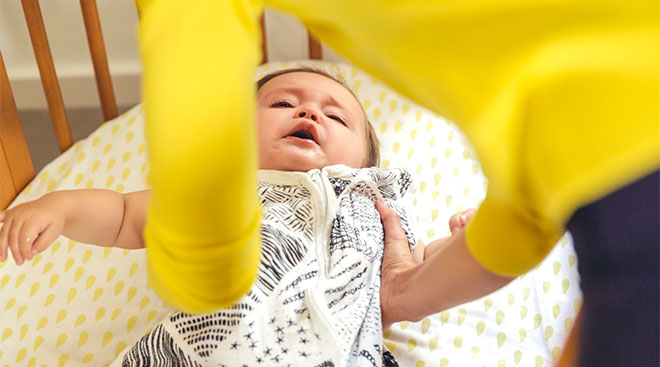HEALTH
The Ferber Method for Sleep Training: A Parent’s Guide

Desperately seeking shut-eye? Learn more about the Ferber method, a popular sleep-training technique that teaches babies to self-soothe and fall asleep independently.
The Ferber method is a sleep-training strategy developed by Richard Ferber, M.D., a pediatrician and the director of the Center for Pediatric Sleep Disorders at Children’s Hospital Boston. In 1985, Dr. Ferber wrote the best-selling book Solve Your Child’s Sleep Problems—which he later updated in 2006—that detailed his method of allowing babies to cry for a certain period of time before comforting them.
The strategy, known as the Ferber method (also called “graduated extinction”), was designed to help babies learn to self-soothe and fall asleep on their own—or fall back to sleep independently if they wake up in the middle of the night.
However, the Ferber method differs from another popular technique called extinction-sleep training (the cry-it-out method)— which is essentially leaving your child, even if they cry, until they go to sleep. “The cry-it-out method was kind of the default mode in the late 19th and early 20th century, where the whole thing was you really shouldn’t spoil your child,” explains Craig Canapari, M.D., director of the sleep medicine program at the Yale School of Medicine and the author of Never Too Late to Sleep Train. The Ferber method differs because it involves checking in on your child at gradually increasing time intervals.
Keep reading to learn more about the Ferber sleep training method, how it works, and when to start “Ferberizing” your little one.
How Does the Ferber Method Work?
While it may not sound easy, implementing the Ferber method is actually quite simple. After following a set bedtime routine, place your drowsy infant in their crib while they’re still awake then leave the room. If they cry, wait for a period of time—Ferber suggests three minutes the first night—before returning to the room to briefly comfort them.
Comforting could be patting your baby or talking in a soothing voice. It should not involve picking them up, feeding them, or turning on the light. This reassurance should last only a minute or two.
Leave the room again, and extend the time period—Ferber suggests five minutes—in which you allow your child to cry. Ferber refers to this technique as “progressive waiting.” If necessary, come in again and briefly comfort them, and then leave while they’re still awake, repeating this process, but extending the wait time to 10 minutes, until they fall asleep without you being in the room. If your child wakes up in the middle of the night, repeat this process to help them go back to sleep.
On the second day, allow your baby to cry for five minutes initially, then 10 minutes, and then 12 minutes. On the third day, begin at 10 minutes, then 12 minutes, and then 15 minutes. The idea is that after a few days of slowly increasing the waiting time, most babies will eventually learn to fall asleep on their own, knowing that Mom or Dad is not going to pick them up when they cry.
How Do You Do the Ferber Method?
Here’s a Ferber method chart detailing the recommended check-in times:
Day 1
- First check-in: 3 minutes
- Second check-in: 5 minutes
- Third check-in: 10 minutes
- Subsequent check-ins: 10 minutes
Day 2
- First check-in: 5 minutes
- Second check-in: 10 minutes
- Third check-in: 12 minutes
- Subsequent check-ins: 12 minutes
Day 3
- First check-in: 10 minutes
- Second check-in: 12 minutes
- Third check-in: 15 minutes
- Subsequent check-ins: 15 minutes
Day 4
- First check-in: 12 minutes
- Second check-in: 15 minutes
- Third check-in: 17 minutes
- Subsequent check-ins: 17 minutes
Day 5
- First check-in: 15 minutes
- Second check-in: 17 minutes
- Third check-in: 20 minutes
- Subsequent check-in after: 20 minutes
Day 6
- First check-in: 17 minutes
- Second check-in: 20 minutes
- Third check-in: 25 minutes
- Subsequent check-ins: 25 minutes
Day 7
- First check-in: 20 minutes
- Second check-in: 25 minutes
- Third check-in: 30 minutes
- Subsequent check-ins: 30 minutes
When Can You Start ‘Ferberizing’ Your Baby?
According to Dr. Canapari, the window for beginning any type of sleep-training method is between 4 to 6 months old. “You can do it up to age 2, but the older your child is, the harder it’s going to be,” he says.
He says for most methods of extinction-based sleep training, including the Ferber method, babies usually cry the hardest on the second or third night. This is referred to as an extinction burst, and it’s often when many parents give up on the method. “When you see that extinction burst,” says Dr. Canapari, “that’s when you’re on the cusp of improvement. I would usually say to people that, generally, the crying is going to be on the downslope, and will get better three to four days after the intervention.”
For some parents, allowing their baby to cry—even for a few seconds—feels cruel. “There’s evidence from an evolutionary standpoint that we are wired to respond to children’s cries,” says Dr. Canapari. “This is a very deep drive, and it kind of goes against our natural inclination to ignore this.” But rest assured that experts haven’t linked the Ferber method to emotional scarring in babies.
Are There Any Tips for Ferber Sleep Training Success?
As often is the case in most child-rearing ventures, the key to making the Ferber method work is consistency. The process should take a few days or a week—not weeks and weeks, says Dr. Canapari. If it’s dragging out, make sure your partner is on the same page as you. Picking up the baby and rocking them when they cry at night can drag out the process. “A lot of parents feel stress or guilt about any sort of behavior modification,” says Dr. Canapari, “but I say you owe it to yourself and your child to have healthy sleep habits.”
Some Other Tips for Ferber Method Success
- Establish a bedtime routine—including bathing, reading books, or other soothing activities—by 6 to 8 weeks of age. This consistency helps your baby learn what to expect each night, and it helps set your baby’s internal clock.
- Avoid sleep training during big life changes for your baby, such as teething or getting a new nanny. Your little one doesn’t need the added stress.
- If your baby still has nighttime feedings, follow the Ferber method chart for getting them back to sleep afterward.
- Place your infant in the crib while they’re still awake, but drowsy. If you put babies to bed when they’re already sleeping, they won’t recognize their surroundings upon waking, making it harder to self-soothe.
- Make sure to implement the Ferber method for naps, too. Most naps should happen in the crib, which helps create a consistent sleep routine.
- Ask your doctor about any concerns you may have.

-

 HEALTH3 months ago
HEALTH3 months agoExploring the Best Cannabis Product Options for Every Lifestyle
-

 BUSINESS3 months ago
BUSINESS3 months agoOn the Frontlines of Conservation: The Role of Tracker Academy Graduates in Anti-Poaching
-

 NEWS3 months ago
NEWS3 months agoLeading Law Firms Specializing in Real Estate Expertise
-

 GUIDE3 months ago
GUIDE3 months agoComparing Online Ordering vs. In-Store Visits at Cannabis Dispensaries